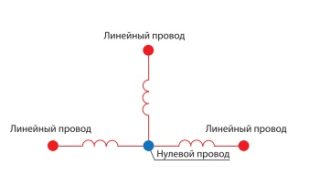In the conditions of modern life, it is impossible to do without household appliances and electronic equipment, the number of which is constantly growing every year. This leads to an increase in energy consumption from the existing power grid and the need to control its operating parameters. This issue is of particular importance in suburban housing, where it is allowed to use 380 volts. For this reason, various options for connecting three-phase electricity in private houses are subject to serious research.
Single-phase and three-phase connection
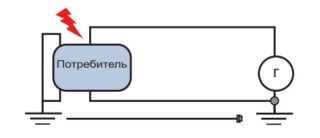
When clarifying the differences in the quality of the two types of power supply (with one- and three-phase connection) and the associated circuit solutions, the following should be noted:
- when using a three-phase system, a cable with 4 cores will be required for laying a line, if there is a grounding loop - with 5, and for a single-phase method, three cores are enough;
- in the first case, the costs of cable products will increase, as well as the purchase of service equipment - a three-phase electric meter, automatic machines and RCDs are more expensive than their single-phase counterparts;
- The power consumed from the substation will noticeably increase, which is explained by the significantly increased loads in the 380 volt network.
These differences are taken into account when preparing a project for the power supply of a private house. Important factors such as current distribution and power losses in a three-phase load due to its reactive nature are also taken into account.
Connection project and required documentation
The project for the power supply of a private house 15 kW 3 phases includes several sections, each of which concerns a certain stage of implementation. At the preparatory stage, the following mandatory activities are carried out:
- preparation and approval of permits;
- drawing of the electrical circuit and the choice of power consumers in reactive load;
- breaking them down into separate groups.
Without a thorough preliminary study of all the subtleties of the project, it will hardly be possible to approve a set of working documentation. Therefore, each of the stages of its preparation needs separate consideration.
Preparation of documentation
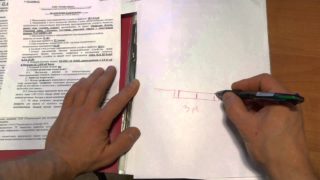
The package of permits is completed on the basis of technical specifications that determine the procedure for the arrangement and operation of a three-phase network. They are issued by representatives of the local Energosbyt. Based on the technical specifications, the following documents are drawn up:
- an agreement with an electricity supplier in the region;
- certificate of inspection of the operated equipment;
- conclusion on the functionality of the circuit, selected for a specific object;
- the act of delimiting the existing power grids according to their balance sheet ownership.
In addition, at this design stage, the features of the operation of specific electricity consumers - pumping and machine-tool equipment in particular, are taken into account.
Scheme and power selection
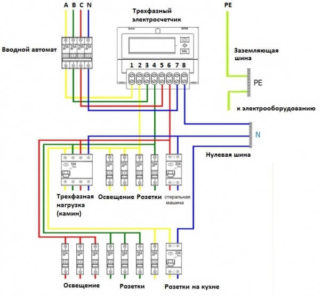
When drawing three-phase electricity connection diagrams in private houses, the following details must be taken into account:
- It must indicate the route of the installation, the type and main characteristics of the wiring cable, as well as the locations of the wiring accessories.
- The same is done with respect to protective equipment: an electricity meter, input and distribution machines, as well as an RCD.
- The diagram also indicates the type of shock protection system used (method of wiring PE and N conductors), as well as the need for re-grounding.
In addition, reference is made to the use of additional protective equipment - voltage monitoring relays in particular.
The calculation of the power consumption in kilowatts is carried out according to a standard algorithm, according to which all indicators for the expected loads are simply added.
For "reactive" consumers (three-phase pumps, machine tools and other equipment equipped with asynchronous motors), a correction factor called the power cosine is introduced. Its load-averaged value is 0.97-0.98.
Breakdown into groups
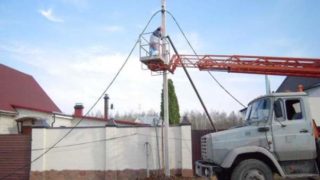
All consumers indicated on the 15 kW house power supply diagram (sockets and lighting devices) are divided into separate groups. Such a division is very convenient for the repair and maintenance of the equipped power supply system. For the functioning of each of these groups, a separate circuit breaker, installed in the electrical panel, is "responsible". With its help, if repair is necessary, for example, you can disconnect only this branch of the wiring, leaving all the others in working order.
For each such group, the calculation of the maximum power consumption is done separately. Based on the data obtained, an automatic machine suitable for the rated current is selected. In addition, they are the basis for the selection of the conductor cross-section for this branch of the home power network.
Lighting lines are laid with a typical wire with a cross-section of at least 1.5 mm2, and in the wiring for connecting outlets, this parameter will need to be increased to 2.5 mm2.
All these data are necessary in order to connect the serviced facility to the power system in accordance with the requirements of the PUE. If they are available, it will be much easier to determine the amount of consumables, protective devices and other types of electrical equipment.
Features of the arrangement of the switchboard
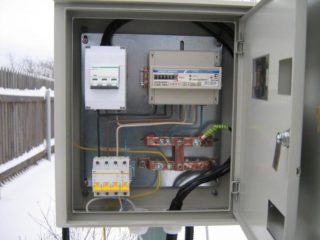
A single-line diagram of a metering board 15 kW 380V (as a special case) is the most common option for building this part of the power supply system. When arranging it, the following configuration options are considered, taking into account the differences between single-phase and three-phase power supplies:
- Use of standard single-pole circuit breakers and RCDs as protective equipment (one for each phase).
- Application in the circuit of some 4-pole differential devices.
- Installation in the panel of two-pole circuit breakers, supplemented by a cross-module and an RCD.
- Installation of single-pole linear circuit breakers together with a 4-pole RCD and a cross module.
Each of these options, if there is space in the dashboard, is suitable for arranging and connecting a full-fledged three-phase power supply system. The choice of a specific set of switching devices depends on the preferences and financial capabilities of the owner of the suburban housing.
Testing wiring
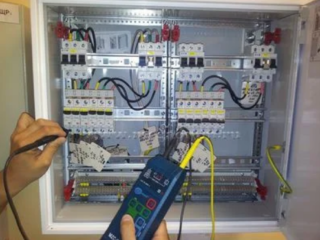
At the end of the installation of the electrical wiring, it is mandatory to check it for operability, which boils down to the following operations:
- First of all, one should "try on" the parameters of current and maximum power selected by calculation to the real operating conditions of electrical equipment.
- To do this, you will need to turn on all the electrical appliances indicated in the project at the same time and check the wiring for insulation heating.
- If the conductors are slightly warm to the touch, and the machines are not constantly knocked out, it is safe to say that all the parameters are selected correctly and the system is ready for normal operation.
When the test program is completely exhausted, they proceed to the final arrangement of the power supply elements. At the final stage, all contact connections in the mounting blocks are once again checked and the operating limits of the RCD and voltage relays are set, adjusted according to the results of test procedures.

